Thrice Were Warriors: Director wraps trilogy with The Convert
The figure of the Maori warrior was central to Lee Tamahori’s first film, and his latest. But is he at peace with it at last?
By Karl Quinn
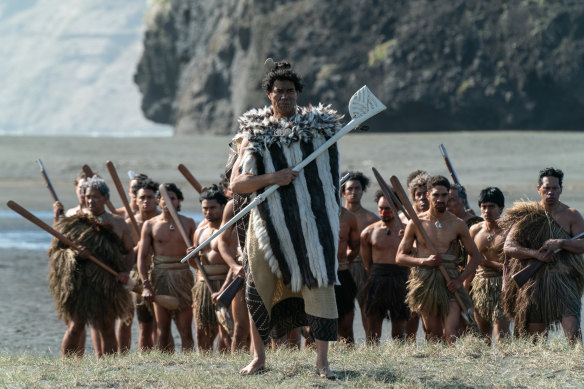
Maori chief Maianui (Antonio Te Maioha) leads his warriors in Lee Tamahori’s film The Convert.Credit: Kirsty Griffin/Kismet
Thirty years after breaking through with his debut feature Once Were Warriors, Lee Tamahori has made The Convert, a film that completes a trilogy he always intended to make – without knowing exactly what it would be about.
Warriors catapulted him into Hollywood, a step that, then aged in his mid-40s, he was more than ready to take. But it also derailed the road map he had laid out for himself.
“I was very aware I hadn’t finished what I planned to do, which was make at least three films – probably only three – in New Zealand, and they would all sort of relate to each other,” he says. “I didn’t know what they would be, but I knew that a triptych or a trio of films seemed to me quite fulfilling.”
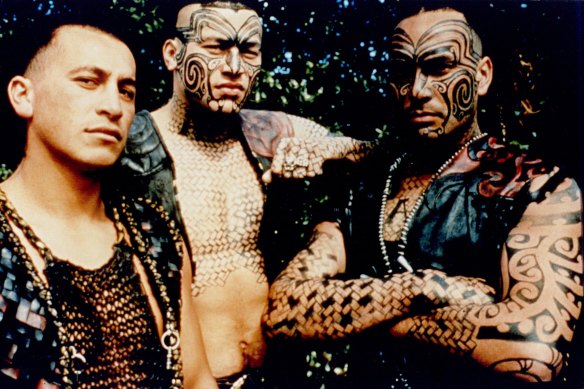
Once Were Warriors catapulted Tamahori to the attention of Hollywood.
As it happens, he has effectively made a trilogy in reverse, with three films about the state of Maori culture at different points in New Zealand’s history since European settlement.
The then-contemporary Once Were Warriors was, he says, a portrait of “a lost culture that was not fit for purpose in the 20th century”, which depicted the Maori as “a people who had moved from the land to the city and were now finding themselves out of work and marginalised”, their lives riven by alcoholism, drug abuse, crime and domestic violence.
Made in 2016, Mahana (aka The Patriarch) was a gentler tale about a Maori man – played by Warriors lead Temuera Morrison – trying to integrate himself into mainstream 1950s society. “It is very much based on my father’s life,” says Tamahori. “My father was educated by the Anglicans in the 1940s and as a young man moved to the city in the first of the urban drift of Maori to make a life for themselves in the new industrialised New Zealand.”
Now comes The Convert, a historical epic set in the 1830s, at a time when Europeans were a tiny minority in the new British colony, living in barely tenable settlements in far-flung locations. They were vastly outnumbered by the Maori, whose appetite for trade and warfare presented both opportunities and dangers for the white settlers.
The story focuses on two warring tribes in the North Island, their relationships with the fledgling British settlements, and a soldier-turned-preacher called Thomas Munro (Guy Pearce) who finds himself in the very exposed middle ground between them.
Though it’s a work of fiction, “everything that happens in the movie has a place in historical fact,” says Tamahori. “The main Maori characters are based on real characters, Munro is based on a collection of Church Missionary Society characters of the day, some of whom were former military guys, and some were running guns. There’s quite a complex history.”
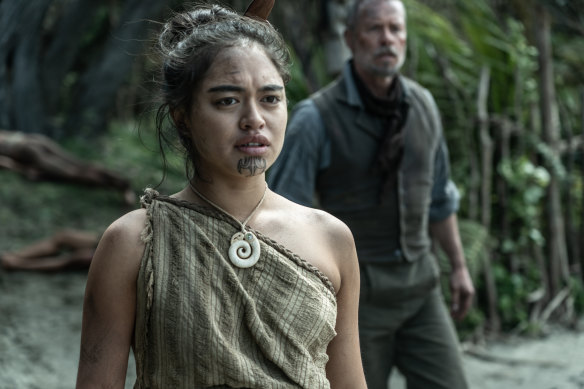
Tioreore Ngatai-Melbourne as Rangimai in Lee Tamahori’s movie The Convert. Credit: Kismet
But while it’s based on facts, it’s not tied to them. And that’s both a matter of choice and an inevitability, he says.
“It was a strangely lawless period of some 15 to 20 years, there are no photographs, just etchings, and written journals by these Church Missionary Society characters, and the oral histories of Maori.
“So it did give us a little flexibility to play fast and loose with history because people could not say one way or another this happened or that happened.
“It’s all based on realities,” he adds. “But I didn’t want to deal with real characters because once you do that you’re caught up with the historical accuracy of what happened.”
There’s no question, though, that the intent was to capture something accurate to the period, and the broad sweep of its history. “I bent over backwards for authenticity in the look of it,” he says. “The locations and the art department were ruthlessly accurate, in pretty much everything we do.”
‘Maori were just as venal and disruptive as Europeans. It’s a magnificent culture, but it’s fraught with problems, like all cultures are.’
Lee Tamahori
On-screen, that translates to clusters of flimsy timber houses perched on the dunes of the beach at Epworth, the English settlement, looking for all the world as if they might be swept away at the first king tide; carved entrances to the pa (Maori villages) that house the warring tribes; the greenstone weapons capable of dealing death with a slit of the throat or a club to the back of the head; and elaborate facial tattoos (some rendered in make-up, others in thin strips of moulded silicon).
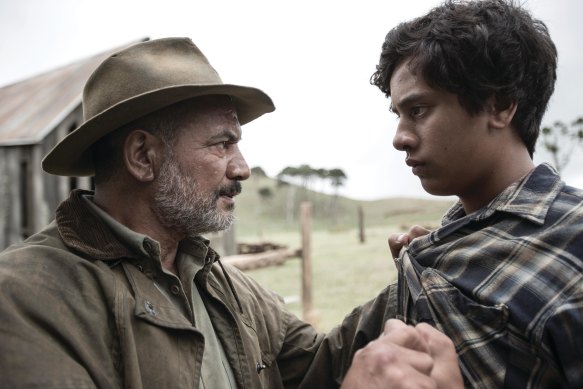
The Patriarch, the middle film in Tamahori’s accidental trilogy, was inspired by his own father’s story.
It’s pretty clear that almost every cent of a budget the director estimates at somewhere between $NZ15-$20 million ($13.9-$18.5 million) has been put on the screen.
With a Maori father and Pakeha (or white) mother, Tamahori is perhaps better positioned than most to tell tales about the interface between these cultures. But growing up, he says, he had almost no relationship to his father’s heritage.
“There was no positivity to speaking the language or embracing the culture,” he says. “He would still do that, but we were brought up and schooled in European methodology. I’m very grateful for that, but as a teenager and in my 20s, I started to yearn for an understanding of the other side of my culture. And once I started making films it became even more pressing and urgent. I straddled both worlds equally well, and I have an understanding and deep affection for both of them.”
As an in-betweener, Tamahori is able to see the good and bad of both Pakeha and Maori culture, both of which are on display in The Convert.
“What I wanted to get across was that Maori were just as venal and disruptive and conniving as Europeans,” he says. “It’s a magnificent culture, but it’s fraught with problems, like all cultures are. I didn’t want to paint the culture as the noble savage or the downtrodden people.
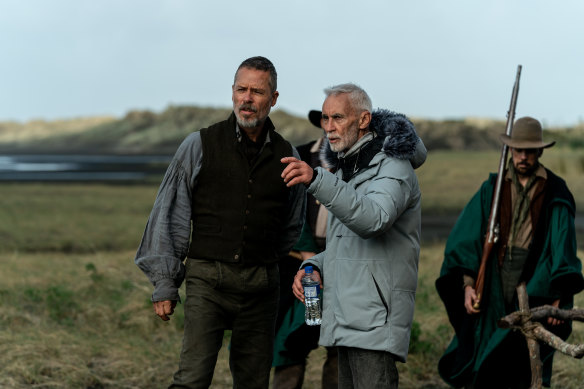
Lee Tamahori on the set of The Convert with leading man Guy Pearce.Credit: Kismet
“It’s a very bellicose culture. There was intertribal warfare on a massive scale and once muskets were introduced into the equation, it became genocidal. And it’s argued by some, with some conviction really, that it was Christianity that saved Maori from self-destruction.
“So they’re very much like the rest of mankind – there was internecine warfare and the enslaving of defeated peoples, and yet there was also a beauty to it, a diplomacy to it, much like medieval Europe, where kings and queens married in order to keep the peace.”
At 74, Tamahori is permanently back in New Zealand, and that initial plan to make “only” three films in and about his homeland is gone. He has plans for a film about the Land Wars, the period from 1845-1860 that follows the events of The Convert; he also has a six-part TV series in mind based on historical events of the 1980s, in which “a bunch of Rastafarians became caught up in a heady mix of Maori nationalism and anarchy and embarked upon a series of arson attacks”.
In other words, the Maori warrior, in its various forms and mutations, remains a figure of fascination.
Tamahori’s depicted that character as lost (Warriors), disconnected (Mahana) and doomed unless open to change (The Convert). But he insists: “I’m not ambivalent about it.
“Some of the biggest warrior characters of the modern day in New Zealand are Maori teachers and people who are engaged in philanthropy, business, and they have a warrior ethic,” he says. “Once you get educated Maori, once they enter into business, they’re formidable characters. They’re the modern inheritors of the old warrior structure.”
The Convert is in cinemas from June 20.
Contact the author at kquinn@theage.com.au, follow him on Facebook at karlquinnjournalist and Twitter at @karlkwin, and read more of his work here.
Find out the next TV, streaming series and movies to add to your must-sees. Get The Watchlist delivered every Thursday.